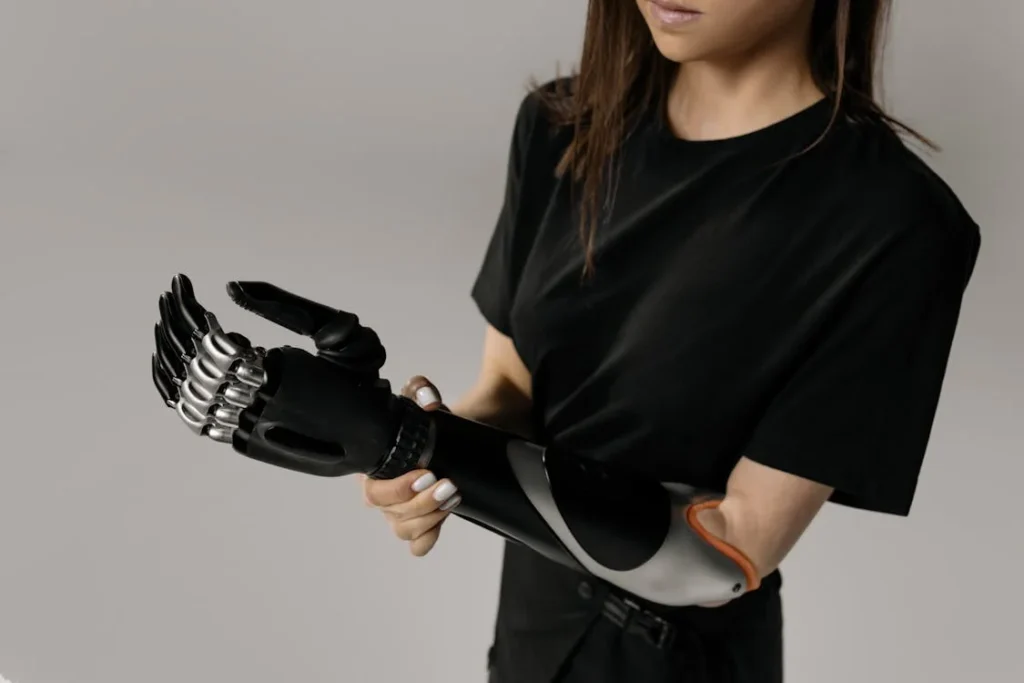When you’re thinking about getting a prosthetic hand—or helping someone else make that choice—it can feel overwhelming. There are so many names, types, and tech features that it’s hard to know what really matters. Some hands use electricity. Some respond to muscles. Others combine different systems altogether. And now, there’s a new contender making waves: the Grippy Bionic Hand.
This hand is designed to bring powerful function with smart grip control in a simpler, more affordable way. But how does it stack up when compared to myoelectric hands and hybrid prosthetics? What makes Grippy different, and is it the right choice for your lifestyle, budget, and everyday needs?

Understanding the Core Differences: What Sets Each Hand Apart
What Makes the Grippy Bionic Hand Special
Let’s start with the Grippy Bionic Hand. At Robobionics, we designed Grippy to solve a simple but important problem: many prosthetic hands on the market are either too basic to be useful or too complex and expensive to be practical.
Grippy sits right in the middle. It gives users real control and real independence—without the steep price, bulky design, or long training hours.
What makes Grippy stand out is how it handles grip patterns. While older hands offer only one or two movements—open and close—Grippy is built with multiple grip styles that allow you to do daily tasks with ease.
Holding a pen, picking up a coin, turning a key, or lifting a water bottle—Grippy knows that each action needs a different type of grip. Instead of needing buttons or apps to switch between modes, Grippy allows quick, intuitive switching that just makes sense once you try it.
The core technology in Grippy is muscle-controlled, like a myoelectric hand, but it’s tuned to be more forgiving. Muscle signals don’t need to be perfect.
The system is trained to pick up even weak or slightly messy signals and still give a smooth, accurate response. This is a big deal for new users or those who’ve had muscle loss after surgery.
Grippy is also built with lightweight materials. It doesn’t feel like you’re dragging a machine on your arm. It’s balanced, breathable, and easy to wear all day.
You can wear it to work, to school, or during daily chores without needing to constantly take breaks because of socket discomfort or weight fatigue.
And then there’s affordability. One of the reasons many users stick with basic hooks or cosmetic hands is because advanced myoelectric hands can cost a small fortune.
Grippy is designed in India, for Indian users, and built to be budget-friendly while still delivering smart performance. It’s not a luxury product—it’s a life tool, built to serve.
Myoelectric Hands: Great Tech, But Not Always Practical
Now let’s talk about traditional myoelectric hands. These are what many people picture when they hear the word “bionic.” These hands read electrical signals from the residual limb muscles through sensors placed inside the socket.
When you contract your muscles, the sensors pick up those signals and trigger the hand to open, close, or do more advanced motions depending on the model.
The biggest advantage of myoelectric hands is precision. They can offer fine control—especially with multi-articulating fingers, which move more like a real hand. High-end versions even allow individual finger control, programmed grip types, and some level of feedback when holding objects.
But that control comes with a cost—literally and figuratively. These hands are very expensive, often imported, and usually not covered fully by insurance. The electronics inside are delicate, so repairs and part replacements can be slow and costly.
There’s also the learning curve. Using a myoelectric hand isn’t automatic. It takes time and practice. Your muscles must be trained to create the right signals, and your brain has to learn how to coordinate those signals with the hand’s response.
It’s doable, but not easy for everyone—especially older adults or children who might have trouble with sustained training.
Another common issue is signal inconsistency. Myoelectric sensors need good, clean contact with your skin. If your arm sweats or the socket shifts slightly, the signals can get noisy.
This leads to poor performance or unresponsive movements. Users often find themselves needing to readjust, recalibrate, or pause mid-task.
Battery life is another concern. Most myoelectric hands need to be charged daily. Some come with swappable batteries, while others need to be plugged in. It’s one more thing to manage in your daily routine.
So while myoelectric hands are undeniably powerful, they are often better suited for users who have access to regular clinical support, stable power, and enough time to train and maintain the device. For many in India, especially in rural or semi-urban settings, this can be a dealbreaker.
Hybrid Hands: Trying to Combine the Best of Both Worlds
Hybrid prosthetics are an attempt to blend body-powered control with electrical features. Typically, this means the user uses shoulder or arm movement to perform the main action—like opening the hand—but can switch to electrical control for certain grips or movements.
Some hybrids also use buttons or touchpads to trigger grip changes.
The idea is to get some of the precision of myoelectric hands without fully relying on muscle signals or high-tech components. This can work well in certain scenarios—especially for people who need a rugged hand but want a bit more versatility than a simple hook.
But hybrid systems often suffer from being too complicated or not intuitive. Switching between body-powered and electrical control modes can feel awkward.
The cables and harnesses needed for body-powered motion can also be uncomfortable, especially during long use. And if the user doesn’t practice regularly, switching modes can become slow or clumsy.
Most hybrid systems still come at a high cost, since they include both mechanical and electronic components. Repairs can be tricky, and not all clinics are trained to handle both systems in one device. While hybrids may offer a step-up from basic devices, they rarely feel seamless.
Grippy, in contrast, doesn’t mix two different control systems. It simplifies everything by focusing on one reliable control method—muscle signals—but pairs it with smarter software that learns from the user’s natural movements.
You don’t need to switch modes or learn different systems. It just works—and keeps working the way you expect.

Real-World Use: How Grippy, Myoelectric, and Hybrid Hands Perform in Daily Life
Handling Everyday Tasks with Confidence
One of the most important things any prosthetic hand must do is make daily life easier. This means being able to perform ordinary tasks—getting dressed, holding utensils, typing, carrying bags—without frustration or constant adjustment. I
t’s in these simple moments where the differences between Grippy, myoelectric, and hybrid prosthetics become most noticeable.
Grippy is built with daily use at the front of our design strategy. It responds quickly to your intention, so if you’re reaching for a spoon or a toothbrush, you don’t have to overthink it. The grip adjusts itself based on how you move and what you’re trying to do.
There’s no fiddling with switches or rotating through menus. This makes it perfect for school-going children, working adults, and anyone who wants their prosthetic to be helpful without being high-maintenance.
Users who try Grippy often report that after just a few days, the actions start to feel natural. You’re not constantly thinking about “how” to grip—you’re just doing it. Whether you’re picking up coins from the table or opening a cupboard, the hand responds in a way that’s fluid, not robotic.
Myoelectric hands, on the other hand, can offer more variety in movements but often require extra thought and precision from the user. You might need to concentrate harder just to switch grips or get the exact finger positions right.
In some cases, you might have to open an app to select the grip type you need. While this level of customization is great in theory, it can slow things down in real life—especially when you’re in a rush or trying to multitask.
Even small things like pulling out a credit card from your wallet or tying a shoelace can become multi-step processes with a traditional myoelectric hand. These hands do offer the most technical accuracy, but the ease of use isn’t always consistent.
You often have to adjust your expectations or work around the prosthetic’s limits, especially if you haven’t used it for a while or are in a noisy environment where the signals get misread.
Hybrid hands sometimes do better in rough use. Because they still use body-powered movement, they can handle heavier force or accidental hits. If you’re working in a warehouse, lifting boxes, or doing physical labor, that mechanical toughness can be helpful.
But in finer tasks—like handling a pen or flipping through pages—they often fall short. The electrical functions can feel like add-ons rather than natural extensions of your movement.
And again, the transition between mechanical and electric control isn’t always smooth. You might be using a shoulder movement to open the hand, and then switching to a button or switch to change grips, which breaks the flow of your action.
Comfort and Wearability Matter More Than You Think
No matter how powerful a prosthetic hand is, if it’s uncomfortable, you won’t want to wear it. A hand that stays in your drawer helps no one. This is another area where Grippy shines. It’s lightweight, breathable, and thoughtfully shaped to avoid pressure points.
Many prosthetic users, especially those new to wearing a device, find heavy or rigid hands difficult to wear for long periods.
With Grippy, we’ve cut down the bulk without losing strength. The battery system is compact, the socket design is ergonomic, and the hand feels balanced—not like it’s pulling your shoulder down. This makes it ideal for all-day use, even in hot climates or long commutes.
Myoelectric hands, especially multi-articulating ones, are often heavier. The internal motors, wiring, and battery pack add weight, and this can lead to fatigue by the end of the day. If you’re wearing the hand for 8 to 10 hours straight—at work, school, or on public transport—you’ll likely feel the strain. Socket comfort also becomes an issue because the added weight increases friction and sweat buildup inside the socket.
Some users also report that the electrical components in myoelectric hands heat up during use. It’s not dangerous, but it can make the device uncomfortable if worn for long hours in India’s warm weather.
Hybrid hands generally fall somewhere in the middle. The mechanical parts are sturdy and simple, which keeps the weight manageable. But once you add in the motors and control systems for the electrical features, the weight starts to creep up again.
And because the harness needed for body-powered control wraps around the shoulder or chest, it can become uncomfortable during movement, especially for women or older adults.
In comparison, Grippy avoids all of this. There are no external harnesses, no complex switching systems, and no heavy internal motors dragging your arm down. It’s simple, soft, and easy to live with.
Battery and Maintenance: Keeping Life Simple
Grippy is designed for real-world conditions. It has a battery that lasts through a typical day’s use, and it charges quickly with a simple plug. You don’t need to remove the battery or carry extra tools. If you plug it in before bed, you’re ready to go in the morning.
The components are modular, so if something wears out—like a fingertip or socket liner—it can be replaced without sending the entire hand back. This cuts down repair time and cost. It’s also built tough enough to handle dust, sweat, and humidity without breaking down.
Myoelectric hands often require more careful maintenance. You have to protect the internal electronics from moisture, make sure the sensors stay clean, and keep track of charging cables and spare batteries.
If something fails—like a sensor strip or motor—the whole hand might need servicing, and spare parts aren’t always readily available.
Many users have to send the hand abroad for repair or wait weeks for replacements, which means living without your hand for extended periods. That’s not just inconvenient—it affects your confidence and independence.
Hybrid hands are simpler to maintain on the mechanical side, but if the electronic components fail, it can be just as problematic. And since not every technician is trained in both body-powered and electronic systems, finding someone who can fix a hybrid hand properly may take time.
With Grippy, we wanted to eliminate those worries. You get a device that’s reliable, easy to charge, and easy to repair. No downtime, no guesswork.

User Experience and Adaptability: What It’s Like to Live With Each Hand
How Fast Can You Adapt?
When someone gets a prosthetic hand, especially for the first time, the learning curve matters more than most people think. The more natural it feels early on, the more likely the user is to keep using it. That’s why we focused on making the Grippy Bionic Hand extremely intuitive from the start.
With Grippy, most users begin feeling confident within just a few days. That’s because the muscle signal recognition doesn’t demand perfection. You don’t need to fire your muscle with exact strength or hit a perfect angle.
Grippy is built to understand the intention behind your movement. If you try to pick something up, the system interprets your effort—even if your signal is weak or inconsistent—and delivers a useful response.
This makes it perfect for users of all ages, including those who may be recovering strength after surgery.
In our experience, users feel more at ease when they don’t have to think about each motion. That mental freedom—being able to focus on the task, not on the hand—is what sets a great prosthetic apart from a good one.
Compare that to myoelectric hands, which can take much longer to get used to. While they offer advanced functions, using them well often involves training with a therapist or prosthetist.
Many users report spending weeks, even months, learning how to fire their muscles correctly. And even after they learn, they may still need occasional recalibration or tuning to get things just right. It’s doable, but it’s work.
Children, especially, may find it hard to stay consistent with training. And older users sometimes struggle with the precision needed to make the hand respond exactly the way they want.
When the signals aren’t perfect, the hand doesn’t move—or worse, it moves in a way that wasn’t intended. That unpredictability can be frustrating and cause people to give up on wearing the hand altogether.
Hybrid prosthetics also demand practice. Because you’re switching between body power and electric control, you’re essentially learning two different systems. The brain has to juggle both methods and apply the right one at the right moment.
This can be confusing at first, and for users who aren’t tech-savvy or comfortable with multi-step operations, it becomes a chore. They may end up using only one function and ignoring the rest, which defeats the purpose of having a hybrid hand in the first place.
In contrast, Grippy keeps everything single-system, smart, and adaptive. That simplicity goes a long way in helping users stick with their prosthetic and feel confident every time they put it on.
How Do the Hands Fit Into Real Life?
A prosthetic hand isn’t just a medical device—it’s part of someone’s identity. Whether you’re at work, at a wedding, or at a café with friends, the look and feel of your prosthetic matters.
Grippy was created to blend in just enough to feel normal, but stand out when needed. It’s sleek and expressive, not bulky or intimidating.
Many users want a hand that looks professional but also allows them to live fully. That includes shaking hands, holding a phone, writing with a pen, or taking care of their children. Grippy supports all of these daily moments with grip styles that feel natural and stable.
For professionals, especially those working in offices or client-facing jobs, Grippy offers a neat, minimal profile. It doesn’t click loudly or jerk unnaturally when in use. It’s quiet, responsive, and socially smooth.
Whether you’re typing at your desk or sipping tea during a meeting, the hand feels like it belongs.
Myoelectric hands, though often designed with realistic skins or metallic finishes, sometimes draw more attention than intended. The advanced look can be impressive, but not everyone wants to be asked questions all the time about their hand.
And during use, the small motor sounds, charging ports, and LED indicators might make them feel more like gadgets than body parts.
Some users love the tech aesthetic, while others find it distracting. And with the added need for phone apps or remote controls, it can sometimes feel like you’re managing a device more than simply using it.
Hybrid hands are usually more functional in appearance. Because they combine mechanical and electronic components, they may have extra parts like cables, straps, or external switches.
While this doesn’t affect performance directly, it can make the hand feel more “machine-like” and less like a seamless extension of the arm. In social settings, the look and motion can draw attention or cause self-consciousness.
With Grippy, we’ve made sure to keep the user in control—not just physically, but emotionally. The design helps users feel proud, not awkward. And since it’s built for Indian lifestyles, it suits everything from traditional wear to work uniforms.
How Well Do the Hands Grow With You?
Another thing that often goes unspoken is how adaptable a prosthetic is over time. Your body changes. Your strength improves. Your needs evolve. Maybe you learn new tasks, start a new job, or take up a hobby that requires different kinds of hand movements.
Grippy is built with this in mind. It learns how you move and adapts to your patterns. You don’t have to keep changing settings every week or seeing a technician for small adjustments.
The system grows with you, understanding your movements better the more you use it. If your muscle signals improve, Grippy adjusts. If you shift how you do things, the hand figures it out and supports the change.
Myoelectric hands also offer some adaptability—but they often require software updates, technician support, or regular recalibration to keep up with your changes.
In some cases, you might even have to retrain the hand to recognize new signal patterns. It’s all possible, but it adds extra steps that can slow down progress.
Hybrids don’t usually adapt on their own. If you change how you move, or if your body changes, you may have to manually adjust tension cables or reprogram grip functions. This means more clinic visits, more tools, and more effort.
By focusing on smart, user-friendly adaptability, Grippy helps users stay active, engaged, and confident—without needing a technician around every time something changes.

Affordability, Support, and Long-Term Value: What You’re Really Paying For
Why Price Alone Doesn’t Tell the Whole Story
When comparing prosthetic hands, the cost is often the first question people ask. And understandably so. These devices are a major investment—not just in money, but in trust. You’re not just buying a product. You’re choosing something that will become part of your daily life.
At Robobionics, we built the Grippy Bionic Hand to be accessible. We know the high price tag of imported myoelectric hands keeps many users from getting the support they need.
Our goal was to create a smart, high-functioning prosthetic that delivers on performance without costing a fortune.
Grippy’s affordability isn’t about cutting corners. It’s about smart engineering. By using locally sourced components, lean design, and simplified mechanics, we’ve made Grippy strong, reliable, and responsive—without unnecessary costs. Y
ou don’t need to pay extra for features you won’t use or tech that demands constant professional calibration.
More importantly, Grippy is easy to maintain. The parts are modular, meaning if one part breaks or wears down, you don’t have to replace the whole hand.
You can simply swap out the damaged part, which keeps long-term costs low. And because our support team is based in India, you get quick help when you need it—no waiting weeks for spare parts to arrive from overseas.
What You Get with a Myoelectric Hand—and What You Don’t
Let’s be honest—myoelectric hands are impressive. They offer advanced grip options, app control, and sleek tech. But with all that comes a price that often starts high and continues to rise.
The upfront cost can be many times that of Grippy, and that’s just for the initial device. If you want full functionality—like multiple grip modes, haptic feedback, or mobile app access—you may need to upgrade to a premium model.
Then there’s the hidden cost: training, servicing, and replacement parts. Every time you need to recalibrate your sensors or repair a small component, you’re either visiting a clinic or waiting for international logistics. If you live in a metro city with access to prosthetic centers, this may be manageable. But for rural users or those with limited travel options, the support gap becomes a serious barrier.
Myoelectric hands also tend to have more fragile components. A drop, a power surge, or exposure to too much moisture can affect performance or cause damage. And while warranties cover some issues, many repairs come out of pocket after a certain period.
For users who love tech and can afford the time, cost, and care these hands demand, they can be a great fit. But for many users, particularly those in India looking for practical function over premium features, the return on investment isn’t always worth it.
Hybrid Systems: Are They Worth the Trade-Off?
Hybrid prosthetics aim to strike a balance—offering some of the benefits of both body-powered and myoelectric systems. But that balance comes with its own challenges.
These hands often fall into an awkward middle ground: more expensive than basic body-powered hands, yet less capable than fully myoelectric ones.
Because hybrids include both cable systems and electrical components, they can be harder to repair and costlier to maintain. You’re essentially maintaining two systems.
And while the idea of having backup control is appealing, many users find that they rely heavily on just one mode, leaving the other underused.
In terms of affordability, hybrids vary. Some are built affordably with local components, while others use imported designs with advanced features.
The price depends heavily on the make, and so does the support. If the hand comes from an international brand, you might run into the same spare parts and service issues you see with high-end myoelectric hands.
What’s missing from most hybrids is fluidity. Switching between control systems takes effort. It doesn’t feel natural to go from using your shoulder to pressing a button or activating an electrical motor. And for many users, especially those new to prosthetics, this disrupts the experience.
What Grippy Offers Beyond the Price Tag
The real value of Grippy goes beyond the number printed on the invoice. It lies in what it does every day for the person wearing it. A hand that’s easy to wear, simple to use, and fast to learn makes a huge difference in someone’s confidence, mobility, and independence.
Grippy allows users to get back to living, not just adapting. Whether you’re tying your shoelaces, peeling vegetables, or catching a bus during rush hour, you don’t want to be second-guessing your prosthetic. You want something that responds, adjusts, and holds up.
And because Grippy is made in India, our service and support team is never far away. From fitting and training to upgrades and repairs, our local presence means you’re never left waiting. You don’t have to rely on import chains or distant service centers. Your solution is right here—close, fast, and responsive.
For parents of children who need prosthetics, Grippy offers another unique advantage: scalability. As your child grows, the device can be resized or adapted without buying an entirely new system. This long-term adaptability saves families both money and emotional stress.
Whether it’s a student going to class, a parent managing the household, or a professional attending client meetings, Grippy offers value where it matters most: in the small, everyday victories that add up to a life lived fully.

Which One Is Right for You? Making the Best Choice for Your Lifestyle
It’s Not Just About Features—It’s About Fit
When you’re comparing prosthetic hands, it’s easy to get caught up in the tech specs. How many grip patterns does it offer? How many motors? Does it connect to an app? These questions matter—but they’re only part of the picture. The most important question is: does it actually work for you in your daily life?
This is where the Grippy Bionic Hand consistently delivers. It was created with real users in mind—people who need to get on with their day, not spend it managing a high-maintenance device.
If you’re someone who wants a hand that’s easy to learn, lightweight, durable, and performs reliably for basic to moderately complex tasks, Grippy is often the ideal match. It gives you the kind of independence that doesn’t come with a long instruction manual or steep learning curve.
If you’re a tech enthusiast, willing to invest more time and money into mastering a more complex system, and if you have regular access to professional support, then a high-end myoelectric hand might be what you’re looking for.
These hands are best for people who want the most customization possible and are comfortable with handling more advanced electronics and controls. But they’re not the easiest to live with, and they’re not always the most forgiving when something goes wrong.
Hybrid hands might suit users who need extra strength or work in physically demanding environments where durability is more important than fine motor control.
They can offer a helpful middle path, especially for those already used to body-powered systems. However, they can also feel like a compromise—neither as simple as a mechanical hook nor as smart as a true bionic hand.
Ultimately, the choice comes down to your priorities. Do you want something that just works—with minimal effort? Or do you want something that requires more time but gives you more control? Do you need support close by? Do you want a device that can adapt over time—or one that needs regular adjustments?
We Designed Grippy for People, Not for Machines
At Robobionics, we believe that technology should serve people—not the other way around. That’s why Grippy was designed with empathy and simplicity at its core.
Every feature is there for a reason. Every design choice was tested with real users. And every improvement comes from listening to people, not trends.
We know that not everyone wants to feel like they’re wearing a machine. You want to feel like you’re whole again. You want to focus on your work, your family, your goals—not your prosthetic.
Grippy helps you do that by being what a great prosthetic should be: strong, reliable, comfortable, and intuitive.
It’s not about comparing tech on paper—it’s about choosing a tool that becomes part of you. One that feels right in your body, fits into your lifestyle, and lets you move forward with confidence.
Conclusion
Choosing the right prosthetic hand isn’t just a technical decision—it’s deeply personal. It affects how you move, how you work, how you interact with others, and how you see yourself. That’s why it’s so important to choose a hand that gives you not only features—but freedom. Grippy stands out because it understands what people really need. It balances smart function with everyday practicality. It doesn’t demand perfect signals or constant attention. It gives you control where it matters, without overwhelming you with complexity.
While myoelectric and hybrid hands have their place, Grippy offers something unique: a hand that’s ready to work with you, not just for you. It’s built for your life, your routine, and your future. If you’re looking for a prosthetic hand that makes daily living easier—not harder—Grippy might just be the hand you’ve been waiting for.
Let us help you grip life with confidence. Get in touch with Robobionics today to find out if Grippy is right for you.



